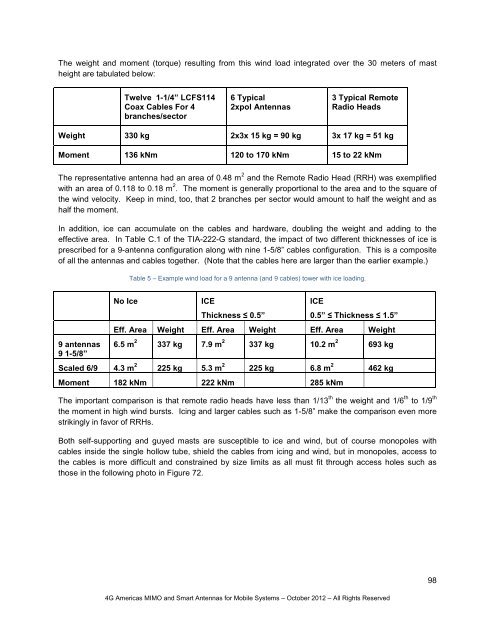MIMO and Smart Antennas for Mobile Broadband ... - 4G Americas
MIMO and Smart Antennas for Mobile Broadband ... - 4G Americas
MIMO and Smart Antennas for Mobile Broadband ... - 4G Americas
Create successful ePaper yourself
Turn your PDF publications into a flip-book with our unique Google optimized e-Paper software.
The weight <strong>and</strong> moment (torque) resulting from this wind load integrated over the 30 meters of mastheight are tabulated below:Twelve 1-1/4” LCFS114Coax Cables For 4branches/sector6 Typical2xpol <strong>Antennas</strong>3 Typical RemoteRadio HeadsWeight 330 kg 2x3x 15 kg = 90 kg 3x 17 kg = 51 kgMoment 136 kNm 120 to 170 kNm 15 to 22 kNmThe representative antenna had an area of 0.48 m 2 <strong>and</strong> the Remote Radio Head (RRH) was exemplifiedwith an area of 0.118 to 0.18 m 2 . The moment is generally proportional to the area <strong>and</strong> to the square ofthe wind velocity. Keep in mind, too, that 2 branches per sector would amount to half the weight <strong>and</strong> ashalf the moment.In addition, ice can accumulate on the cables <strong>and</strong> hardware, doubling the weight <strong>and</strong> adding to theeffective area. In Table C.1 of the TIA-222-G st<strong>and</strong>ard, the impact of two different thicknesses of ice isprescribed <strong>for</strong> a 9-antenna configuration along with nine 1-5/8” cables configuration. This is a compositeof all the antennas <strong>and</strong> cables together. (Note that the cables here are larger than the earlier example.)Table 5 – Example wind load <strong>for</strong> a 9 antenna (<strong>and</strong> 9 cables) tower with ice loading.9 antennas9 1-5/8”No IceICEThickness ≤ 0.5”ICE0.5” ≤ Thickness ≤ 1.5”Eff. Area Weight Eff. Area Weight Eff. Area Weight6.5 m 2 337 kg 7.9 m 2 337 kg 10.2 m 2 693 kgScaled 6/9 4.3 m 2 225 kg 5.3 m 2 225 kg 6.8 m 2 462 kgMoment 182 kNm 222 kNm 285 kNmThe important comparison is that remote radio heads have less than 1/13 th the weight <strong>and</strong> 1/6 th to 1/9 ththe moment in high wind bursts. Icing <strong>and</strong> larger cables such as 1-5/8” make the comparison even morestrikingly in favor of RRHs.Both self-supporting <strong>and</strong> guyed masts are susceptible to ice <strong>and</strong> wind, but of course monopoles withcables inside the single hollow tube, shield the cables from icing <strong>and</strong> wind, but in monopoles, access tothe cables is more difficult <strong>and</strong> constrained by size limits as all must fit through access holes such asthose in the following photo in Figure 72.<strong>4G</strong> <strong>Americas</strong> <strong>MIMO</strong> <strong>and</strong> <strong>Smart</strong> <strong>Antennas</strong> <strong>for</strong> <strong>Mobile</strong> Systems – October 2012 – All Rights Reserved98
















